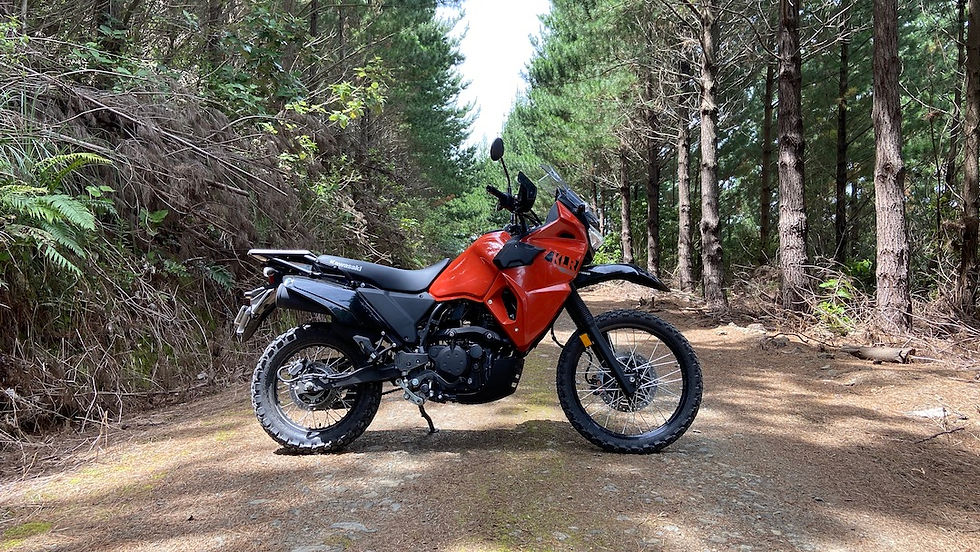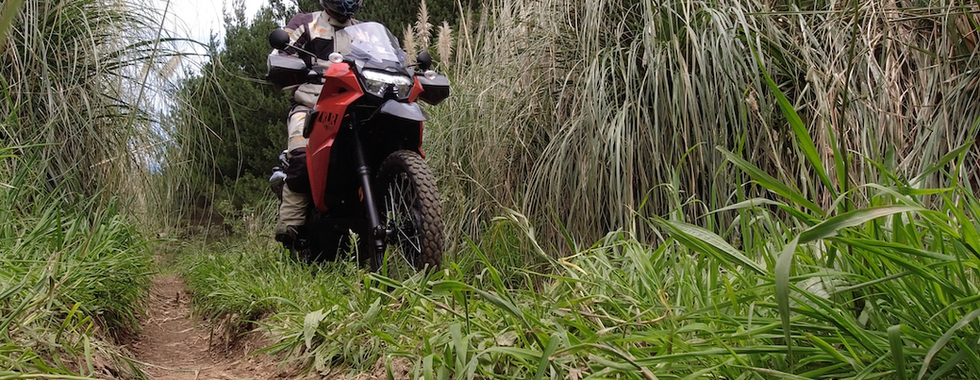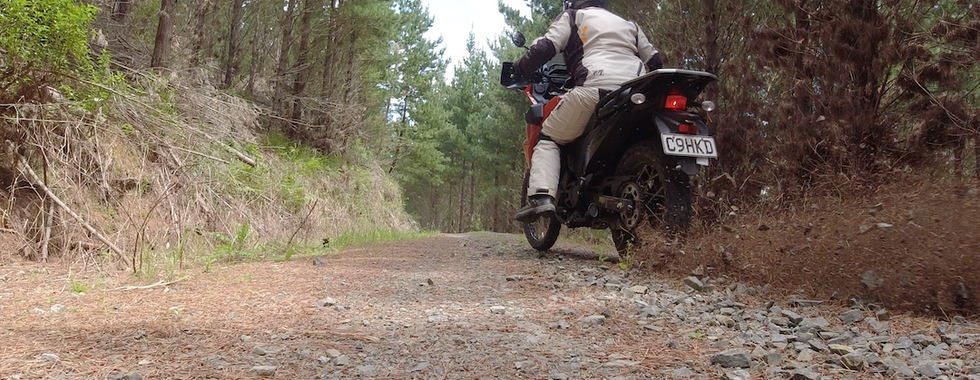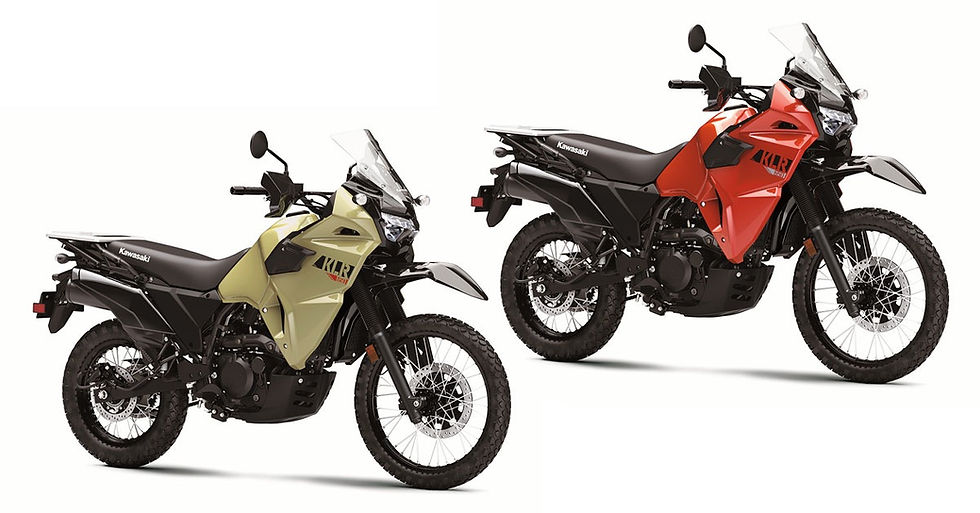Back From The Dead | 2022 Kawasaki KLR650 Review
- Mathieu Day-Gillett

- Jan 3, 2022
- 7 min read
Updated: Nov 29, 2023

Kawasaki’s overland icon is back with the revival of the KLR650 with its biggest update ever. Question is, did the KLR650 need to come back from the dead or was the platform better left in its shallow grave?
I’ll be honest, I was surprised when Kawasaki brought the KLR650 back. Heavily modernised, the KLR now sports a new look, ABS backed brakes and most importantly - Fuel Injection.
I was both thrilled and a little disappointed. Surely Team Green could’ve revived their other adventure offering, the twin-cylinder KLE500, as a competitive entry-level adventure bike. But what we got is the return of the ever-popular KLR (something you could never say if the KLE500) with the necessary modern amenities.
It sounds like a good package, but in practice does the KLR still have a place in the modern adventure market or is it a wandering zombie that has somehow ambled back from the grave?

It’s a hard question to answer. With such a broad range of bikes now available in the NZ adventure segment, the KLR650 is a rather unique proposition these days. With its 650cc single, large tank and good touring amenities the KLR straddles the definition of a dual-sport and an adventure tourer. It also comes in at an attainable price and is backed by decades of development on what is essentially the same platform. For the 2022 KLR650, Kawasaki upgraded the tried and true platform with a number of key changes. The over 30-year-old engine has been brought up to modern emissions standards (a feat in itself), with renewed attention paid to rider comfort along with a new visual design, LED lighting and ABS braking. There’s also a factory accessorised KLR650 Adventure model which adds luggage frames, hard panniers, crash protection and fog lights to the package for an additional cost.
As you might expect the cost of entry has gone up a bit compared to the second-generation bike, with the 2022 KLR650 entering the market at $11,495. The kitted out adventure model retails for $12,995 which saves you $1817 compared to adding each of the Adventure model’s extras to a base model bike.
Considering what Kawasaki has changed, the jump in price isn’t particularly severe and the KLR650 remains an affordable option for the adventure-minded rider.

2022 Model Updates
Starting with the frame, Kawasaki has replaced the problematic subframe which had a tendency to break its mounting bolts with heavy touring loads. This is now welded to the frame so this should improve reliability, so long as you don’t bin the bike and damage it.
The engine has received a slew of updates as well, with the most prominent being the switch to a Keihin EFI system. Fuelling is quite good, with the best bit in my book the ease of which the big single now comes to life.

While other countries will get the option of a KLR without ABS, NZ models only come in ABS guise. The new ABS regulations appear to have worked in Kawasaki’s favour as they’ve killed off the KLR’s primary competition – the top-selling Suzuki DR650.
The ABS isn’t switchable, which is a real shame as I think it might put a few people off. However, it is a forgiving system off-road however, more on that later.
The KLR’s cockpit has had a total redesign as well, with the analogue gauges replaced with a digital display that offers all the usual info, except a tachometer or gear position indicator. It does, however, offer a fuel gauge for the massive 23-litre fuel tank for the first time.
Atop the digital display is a handy mounting bar on which to clamp a GPS, GoPro style action camera or whatever your heart desires. It's a nice feature that adds more potential out of the box and should help negate the need to add aftermarket mounts here.

On the base model, there are plenty of blanking plates also in the cockpit for your to add your own accessories to. On the Adventure model, these are used by switches for fog lights and a waterproof charging point into the mix.
The plastics have all been revised with the exception of the front fender, which carries over from the Gen 2 model. This is one area the KLR shows its budget nature as the front cowlings feel like great quality sturdy plastic, while the rear plastics feel noticeably softer/cheaper and flex a lot when you give them a wiggle. The right rear cowling in particular is possibly the worst here, but as it is a contact point for when the bike is dropped, I suspect Kawasaki did this on purpose for durability’s sake. The harder plastic of the main fairings are similarly protected by smaller sacrificial plastic parts that should act as the first point of contact should you drop the bike, thus protecting the main fairing from damage which has been a point of concern for more adventurous riders since the debut of the Gen 2 model.
Interestingly, the new KLR650 actually weighs a couple of boxes of beer heavier than its predecessor at 210kg wet. That’s still in the ballpark for what ADV riders expect but is still around 15kg heavier than the old bike. Where that weight has come from I have no idea but at a guess, the longer swingarm is partly to blame along with the additional electronics and ABS system.

With the KLR being primarily a travel bike these days Kawasaki put a lot of effort into reducing the vibrations that reach the rider. For the most part, their efforts have worked nicely. The bars are rubber mounted, as are the seat and footpegs (more on those later) so your primary contact points are pretty well insulated. At least compared to the old bikes. However, the fuel tank doesn’t appear to have received the same attention and clamping the tank with your knees quickly reminds you you’re riding a large capacity single.
Power is still transferred to the ground through a 5-speed gearbox, and while a 6-speed is the expectation these days I honestly didn’t find myself hunting for a 6th gear often during my time with the KLR. For adventure touring at least, the factory gearing seems pretty good for New Zealand conditions and our low highway speed limits.
On The Highway

With the Waikato returning to alert level two, I leapt at the opportunity to take the KLR to the Coromandel for a catchup with family and the obligatory play out on the local forestry roads.
Crossing the Hauraki Plains on the KLR was a generally comfy affair. The work Team Green has put into reducing vibrations felt by riders has paid off compared to my memories of the Gen-2 bike.
The cockpit is a pretty pleasant place to be in general. The big brush guards deflect most of the wind from your hands and lower arms while the screen and fairing take the pressure off your chest and shoulders. With the windscreen set in its lowest position, I found it directed wind directly at my eye line… Good for keeping me ventilated on a hot day but not so great in terms of buffeting.
Pulling out the tools from the factory toolset and I had the screen mounted in the high position after a couple of minutes. To be honest I didn’t notice much change in the buffeting around my head but it made it easier to duck down into the still air pocket behind the screen.
It’s a bike that actually feels like it connects you to the road through mechanics rather than witchcraft and the thrum of the engine as you roll along the countryside I found was quite soothing. Sure, it’s not the fastest, but it was noticeably easier to ride in a relaxed fashion on the highway than my CRF250L Rally.
Off The Beaten Path

With a few hours set aside to muck about on the KLR in the forestry, I set out for a few old favourites from my misspent youth with what I thought was a good idea on how the big KLR would perform.
My primary thoughts were it would wallow about considering its substantial weight and the non-switchable ABS would prove to be a major limiting factor. Naturally, as with all assumptions the KLR made me feel like a bit of an ass at the end of the day for assuming its overall capability was lacking.

The 41mm fork is surprisingly pliable and lacks the major dive I was expecting under braking, while the unitrack rear shock offers both preload and rebound damping with an easy to access clicker at the base of the unit.
It’s still a big dual-sport and is indeed quite capable off the tar, but those modern amenities and comfort add ons do become a slight hindrance when it’s time to stand up and be counted.
The large 23-litre fuel tank and wide luxurious seat emphasize the KLR’s size, especially in tight twisty singletracks, at least compared to smaller bikes. It certainly feels more of a tourer than a trail weapon.

The biggest “crime” Kawasaki has performed on the new KLR650 is its footpegs. Okay, out on the road, they are actually fantastic and do their job of not transferring vibrations to the rider, but off the seal, they are far from great. All that rubber translates to little confidence standing up and I often felt like my feet were sliding off the pegs. If I owned the 2022 KLR, a set of cleated footpegs would be where I would spend my first dollars farkling up the bike.
Despite the footpegs and its general girth, the KLR surprised me yet again when I found myself on what turned out to be a walking track in the forest behind Onemana. Even with its non-switchable ABS, the KLR happily navigated through the tight track with the confidence I wish I could say I had as I first turned its wheels onto the downhill track.
The ABS did activate a couple of times on me, but I was surprised at how much room it gave you before it intervened. Keeping the idea of progressive braking in mind seemed to help to prevent it from activating, too. I do suspect, however, that if more advanced adventure riding is in your plans you’d want to pull the fuse to the ABS to ensure in tight technical riding it doesn’t cause you any unwanted grief.

So did Kawasaki make the right call bringing back its three-decade-old single back from the dead?
I think it was for a couple of reasons.
The first is the undeniable popularity and legacy of the KLR650. No bike sticks in a manufacturers lineup for over 30 consecutive years without good reason. While I love the idea of a modern KLE500 that model never grew to the cult following the KLR650 did.
The second reason is the KLR now occupies a reasonably unique section in the marketplace. As I mentioned earlier, the KLR's biggest competition in both price, spec and origin (the Suzuki DR650) is no longer available new due to our ABS laws and the only other manufacturers selling large capacity single-cylinder motorcycles is KTM/Husqvarna - both of these come in at a much higher price point with more tech and higher performance.
With the KLR offering a well thought out and characterful single-cylinder adventure platform at a very attainable price, it makes complete sense that Kawasaki opted to give the model a full refresh for 2022.























































